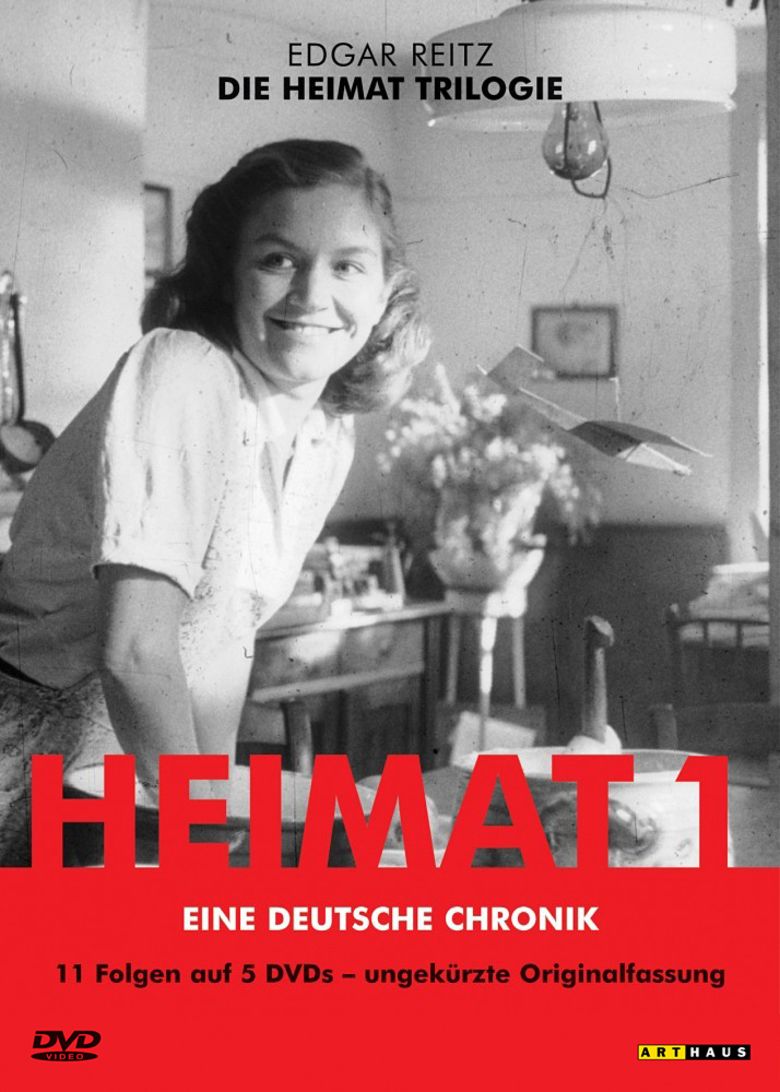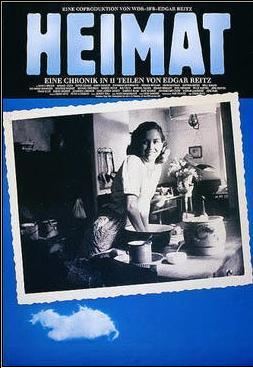Heimat (film series)
9.2 /10 1 Votes
Duration Language GermanHunsruckisch | 9/10 IMDb | |||||||||||||||||||||||||||||||||
 | ||||||||||||||||||||||||||||||||||
Release date 16 September 1984 — 13 October 2013 | ||||||||||||||||||||||||||||||||||
Trailer heimat eine deutsche chronik heimat 1 nederlands ondertiteld
Heimat is the overall title of several series of films in 32 episodes written and directed by Edgar Reitz which view life in Germany between 1919 and 2000 through the eyes of a family from the Hunsrück area of the Rhineland. Personal and domestic life is set against glimpses of wider social and political events. The combined length of the 32 films is 53 hours and 25 minutes, making it one of the longest series of feature-length films in cinema history.
Contents
- Trailer heimat eine deutsche chronik heimat 1 nederlands ondertiteld
- Tales from the Hunsrck Villages
- Autobiographical elements
- Heimat
- Die zweite Heimat Leaving Home
- Heimat 3
- Heimat Fragmente Heimat Fragments
- Die andere Heimat Home from Home
- Simon family
- Wiegand family
- Schirmer family
- Other characters
- Reception
- References

The title Heimat (pronounced [ˈhaɪmat]) is a German word meaning "homeland" or "home place." Usage has come to include that of an ironic reference to the film genre known as Heimatfilm which was popular in Germany in the 1950s. Heimat films were characterized by rural settings, sentimental tone and simplistic morality.
Aesthetically, all three series are notable for their frequent switching between color and black-and-white film to convey different emotional states.
Tales from the Hunsrück Villages
Before creating the Heimat series Reitz produced a documentary from 1980–81 about people from his home region, the Hunsrück, in which he later set the Heimat series. In Geschichten aus den Hunsrückdörfern ("Tales from the Hunsrück Villages") he showed people who hadn't left the region. This documentary is not considered to be part of the core Heimat series but set the stage for the work to come a few years later. It is further interesting because the documentary is about staying in the region, staying home, while the later series is about leaving home.
Autobiographical elements
Berkeley Film and Media Professor, Anton Kaes (1989) argued that auteur film-maker Edgar Reitz's trilogy was autobiographical. Reitz and Paul Simon, his fictional character in Heimat had fathers who were skilled craftsmen. Edgar Reitz was born in 1932 and Paul Simon in 1898 in Hunsrück. They grew up there, then left when they were in their twenties and returned in their fifties. Like Hermann Simon, in the 1950s, Reitz left rural life for the world of German urban avant-garde arts and intelligentsia. Reitz worked at the Institute of Film Design in Ulm, while Hermann became a celebrated conductor in Munich. Wealthy American entrepreneur Paul Simon returned to Hunsrück only briefly when the war ended, but Hermann Simon's return was more permanent. He and his lover Clarissa restored a house overlooking the Rhine that lay in ruins, eventually composing music for representing and celebrating his relationship to heimat. Both Hermann and Reitz 'dramatized the tensions between staying home, leaving and returning (Kaes 1989:164)', Hermann through music and Reitz through film.
Heimat
Heimat, the original series, premiered in 1984 and follows the life of Maria Simon (Marita Breuer), a woman living in the fictional village of Schabbach (the village of Woppenroth in Rhein-Hunsrück, a very rural region of Germany to the west of the Rhine, was used for filming). The film spans the years 1919 to 1982. Subtitled Eine Deutsche Chronik — A German Chronicle, it consists of 11 episodes running in total to 15 hours 24 minutes of screen time and depicts how the events of German history affected the Simon family and the community in which they lived.
Die zweite Heimat (Leaving Home)
Die zweite Heimat (literally "The Second Heimat", and called, in the English version, Leaving Home) (subtitled Chronik einer Jugend — Chronicle of a Youth) followed in 1992. It tells the story of how Maria's youngest son Hermann leaves his rural home and makes a new life for himself as a composer in Munich during the socially turbulent years of the 1960s.
Hermann is a musical prodigy whose teenage romance in 1955 with 26-year-old soul mate Klärchen was considered scandalous by his conservative home village. It resulted in her being expelled and coerced not to contact him ever again. Hermann was crushed and vowed never to love again and to leave his wicked village forever. He arrives in Munich at age 19, overwhelmed and with no place to stay. He finds a private room opening in a month, leaving the deposit with a flamboyant Hungarian woman. His friend Renate, a law student, allows Hermann to sleep on her floor but he is put off by her sexual advances. He finally rooms with Clemens, a fellow Hunsrücker who plays jazz drums in Munich's clubs. Hermann is accepted into the music conservatory, where he meets the incredibly talented Juan from Chile, whose school application is rejected on the grounds his marimbas are "folklore". Hermann and Juan network with the avant-garde culture surrounding the conservatory, including film students, while Hermann takes on odd jobs and Juan works as a gymnast teacher. Both Juan and Hermann have a brief fling with the beautiful cellist Clarissa, who fears intimacy but is drawn to those who fear it too. The students are gradually drawn to the Foxhole, a mansion headed by a wealthy art patroness said to be a "collector of artists".
Heimat 3
Heimat 3 (subtitled Chronik einer Zeitenwende — Chronicle of a Changing Time) premiered in 2004. It picks up Hermann's story in 1989 as he returns to Schabbach and depicts the events of the period from the fall of the Berlin Wall until 2000. The cinema version consists of six episodes running to 11 hours 29 minutes, although controversially the version broadcast on the German ARD television network in December 2004 was edited to six ninety-minute episodes and it is this shortened version which was released on DVD.
Heimat-Fragmente (Heimat Fragments)
Heimat-Fragmente (English title Heimat Fragments), subtitled Die Frauen — The Women, was released on cinema in 2006 and focuses on the women of the Simon family at the turn of the millennium, and in the 1960s.
Die andere Heimat (Home from Home)
In April 2012 Reitz started filming a prequel to the series: Die andere Heimat (literally "The other Heimat" but it was given the English title Home from Home), with the subtitle Chronik einer Sehnsucht — Chronicle of a Vision. The film takes place between 1840 and 1844 and centres around two brothers, their families and love relations from the Hunsrück area and their decision whether to flee hunger and poverty by emigrating to Brazil. Principal filming was completed in August 2012. It was screened at the Venice Film Festival in September 2013. The film was awarded a score of 70 on critical aggeagator website Metacritic, indicating generally favorable reviews.
Simon family
Wiegand family
Schirmer family
Other characters
Reception
Heimat was one of director Stanley Kubrick's favourite films. It is ranked #59 in Empire magazines "The 100 Best Films Of World Cinema" in 2010. It also finished in 6th place when BBC Two ran a 40th birthday poll celebrating the station's greatest programmes and was 10th in Channel 4's 50 Greatest TV Dramas.
Heimat has faced some criticism for its selective interpretation of German history, with some writers noting that there is limited treatment of the hyperinflationary spiral of the 1920s, the Great Depression, or certain aspects of Nazi history such as the Holocaust of World War II. Writing in The New York Review of Books in 1985, Timothy Garton Ash said:
When you show the 1930s as a golden age of prosperity and excitement in the German countryside, when you are shown the Germans as victims of the war, then you inevitably find yourself asking: But what about the other side? What about Auschwitz? Where is the director's moral judgment? To which the color filters insistently reply: 'Remember, remember, this is a film about what Germans remember. Some things they remember in full color. Some in sepia. Others they prefer to forget. Memory is selective. Memory is partial. Memory is amoral.'
Heimat's themes of decadent American values and Western corporate greed rising up against the innocent simplicity of the Hunsrück have been seen as "resurrecting a discourse that prevailed in the nineteenth century about the modernization of Germany's society and economy ... no compromises or delicate balances are possible".
Barbara Gabriel argued that the series was part of a larger movement of national memory work in Germany, provoked in part by the American television series Holocaust. As European art in general and German art in particular resurged in the 1960s, artists like Günter Grass and Edgar Reitz captured international attention as they grappled with issues of identity in a divided, post-Holocaust Germany.
References
Heimat (film series) WikipediaHeimat (film series) IMDb Heimat (film series) themoviedb.org
